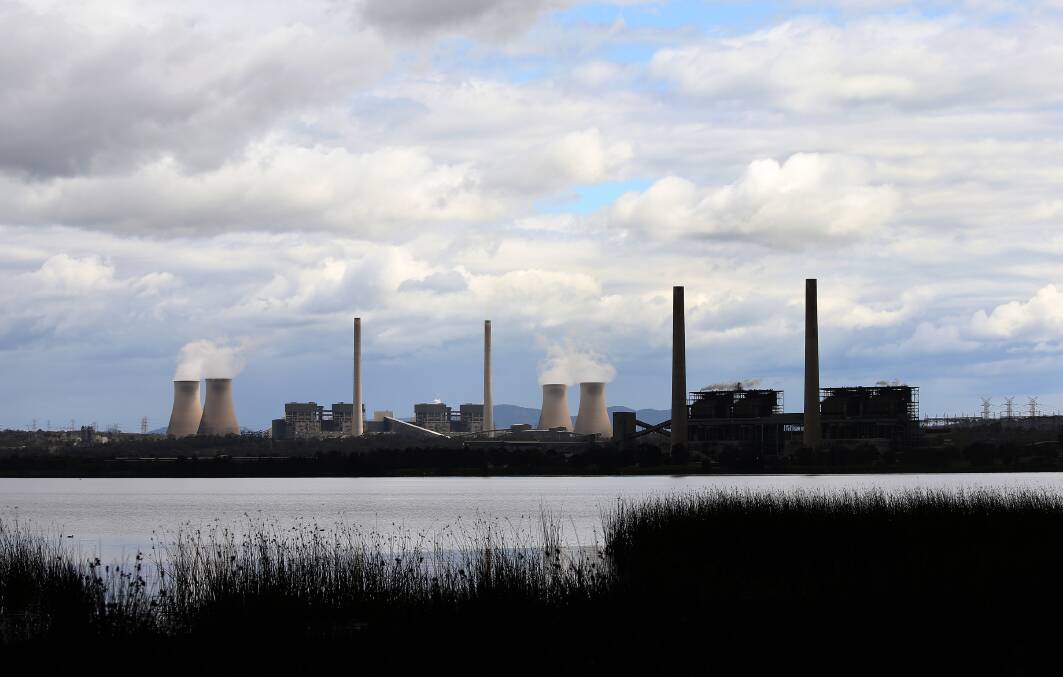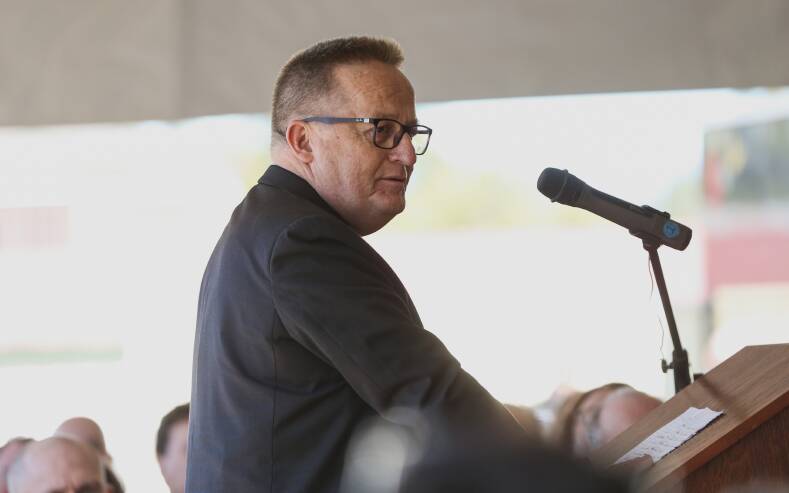
THE Mining and Energy Union has renewed its push for a federally legislated energy transition authority to help the mining and power station workforce cope with the loss of employment that will accompany the closure of coal-fired power stations and the eventual winding down of the coal industry.
At a delegates' meeting in Sydney attended by more than 70 mine-site delegates from some 25 sites in four states, the union's national president, Tony Maher, said accelerated power station closures meant the authority needed to be established immediately.
"If Australia doesn't get an Energy Transition Authority established in time it would be a moral failure, because it's wrong to expect blue-collar workers to bear the brunt of the nation's climate change action when the costs could easily be shared," Mr Maher told the meeting yesterday.
"But it would also be an epic social and political failure. Entire regions that have historically relied on coal station employment will face economic devastation if workers are hung out to dry.
"The community will then have to pay for all the horrible social consequences we know will transpire.
"And if we allow climate change action in Australia to become a pitiless game of winners and losers, we leave the door wide open to more climate wars."
Mount Piper power station operator Peter Compton said workers had "a front-row seat" to the changes but their interests were "not being taken into account".
"The closures are going to have an enormous impact on our lives and communities and these outcomes need to planned for too," Mr Compton said.
Mr Maher said "an impressive range" of measures had been offered by state governments and employees but they had their limitations and federal intervention was needed.
The union commissioned a University of NSW report in 2018 on the need for a "just transition" for power and coal workers, and other unions and community groups have also pushed for a federal transition authority.
The Greens challenged Labor to support its National Energy Transition Authority Bill, introduced to the Senate late last year by Greens Queensland Senator Penny Allman-Payne.
"The only thing standing in the way of the creation of a National Energy Transition Authority is the Labor Party," Senator Payne-Allman said at the time.
"Labor has said they will consider the Greens' proposal, but we think they should listen to what workers, unions, businesses and their own members are saying and commit to backing our bill."

To see more stories and read today's paper download the Newcastle Herald news app here.
The full text of Mr Maher's speech
The last decade of federal politics showed us that ignoring the profound global economic transformation underway due to decarbonisation doesn't make it go away.
The absence of a coherent energy or emissions-reduction policy under the previous government didn't stop the world changing.
Major companies set their own emissions-reduction targets and pathways; as did state governments. Investors got organised.
Technology continued to advance and commercialise.
As it turned out, the political dividend from trashing prior political bipartisanship on climate change had a limited shelf life, which had well and truly expired by last May.
And while the new Government has set about creating the architecture to reduce emissions and support industry through the profound economic restructuring underway, there is a critical element missing.
That is - support for the workers who are most imminently and profoundly affected by decarbonisation.
As representatives of workers from Australia's coal-fired power stations and the coal mines that supply them. That's you and your workmates.
Our union has advocated for a federal Energy Transition Authority for some years.
It is not a new concept - but today I'm going to make the case that establishing such a body is a necessary and urgent reform.
Given the speed at which coal fire power stations are now accelerating toward closure; the Federal Government has to establish an Energy Transition Authority this year or it will probably be too late.
If Australia doesn't get an Energy Transition Authority established in time it would be a moral failure, because it's wrong to expect blue collar workers to bear the brunt of the nation's climate change action when the costs could easily be shared.
But it would also be an epic social and political failure.
Entire regions that have historically relied on coal station employment will face economic devastation if workers are hung out to dry.
The community will then have to pay for all the horrible social consequences we know will transpire.
And if we allow climate change action in Australia to become a pitiless game of winners and losers, we leave the door wide open to more climate wars.
A Labor Government can't afford to leave this transition to the likes of Double Bay Jesus or capitulate to the myopic world view of inner city Teals.
It needs to embrace its historic mission and ensure it's not average working families who are forced to be the fall guys.
This is the current state of play: both major parties have now committed to net zero emissions by 2050.
Every State and Territory Government, of any persuasion, has the same or more ambitious targets.
The Federal Labor Government was elected with a mandate for a 43% reduction compared with 2005 levels by 2030 and it has legislated those targets.
Here in NSW, net zero by 2050 is underpinned by targets of 50% reduction by 2030 and 70% by 2035.
An important element of the Government's emissions-reduction plan is a ramped-up Safeguard Mechanism, requiring 215 of our highest polluting industrial facilities to reduce their on-site emissions by almost 5% per year.
There has been considerable business support expressed publicly for this scheme and a considerable effort by Government to accommodate the feedback of industry.
Given that 59 of the facilities covered by the safeguard mechanism are coal mines, our union is actively advocating for their interests in this process.
We want to make sure coal mines have access to the same flexibilities in how they reduce emissions as other industries, including access to credits, recognising that some changes and technologies will take time to implement.
Coal mine operators are grappling with how to reduce emissions - which mostly come from the vast amount of diesel they use in machinery and the greenhouse gases released from coal seams.
There have been some significant advances like ventilation air methane abatement technologies.
Their uptake can help to extend the life of coal mines and the jobs they sustain.
If done well, the Safeguard Mechanism can incentivise emissions reduction in a way that doesn't lead to early closures.
Power stations are not covered by the Safeguard Mechanism individually.
Instead, there is an industry baseline set for grid-connected energy generators recognising that they operate through a National Energy Market.
The sectoral baseline is set at 198 million tonnes CO2-equivalent - which is based on industry emissions 10 years ago - but current emissions from grid-connected generation are about 50 million tonnes below.
Unlike coal mines, power stations are not struggling with how to abate their emissions.
Emissions reduction is being driven by the greater share of renewables into the National Electricity Market (NEM) and power stations closing as they reach the end of their operating lives or economic viability.
We have known the trajectory of coal power for some time, but now we are seeing the timeline for power station closures rapidly shortening.
Last year, WA announced plans to close its coal-fired power stations by 2030.
Queensland followed suit, announcing its coal-fired power stations will not run beyond 2035.
In the states where power stations are privately owned, closure dates also came forward.
Origin announced Eraring in NSW would close in 2025, seven years earlier than previously scheduled.
AGL brought forward the closure of Loy Yang A in Victoria to 2035, 10 years earlier than previously scheduled.
Our members at AGL are the next cabs off the rank with the impending closure of Liddell in the Hunter Valley coming now scheduled for 28 April.
And as if they haven't been through enough, they were treated to a techbro showdown last year with Mike Cannon-Brookes taking on the AGL board.
After he was part of a successful push to prevent AGL from splitting off its coal power assets - with the purpose of shutting them down sooner - the second coming of Double Bay Jesus saw all four of his board picks elected.
The whole episode created enormous uncertainty and led to AGL being without a CEO for several months.
But the fact is that energy workers know their industry is under pressure on all fronts - we don't need tech billionaires in green capes to tell us.
Based on the current commitments of operators and state governments - and the trend of accelerating closure timelines - we are unlikely to have coal-fired electricity generated in Australia beyond 2035.
Over the course of this meeting, we are going to discuss some of the different technologies utilising coal and how they may be applied in Australia.
We are the union for coal miners and power station workers and we support the industries and jobs that employ our members.
If there was a serious proposal for a new coal-fired power station to be built, that stacked up economically and utilised emissions-reduction technology, we would support it.
But at the moment, there is no such proposal.
Even if there were one or two, it wouldn't significantly alter the projected change in Australia's energy mix.
With the influx of cheaper renewables, investors have spoken.
They are saying that the business case for building and operating new baseload coal-fired power stations isn't there.
That doesn't mean the system is ready yet for the change underway.
Investment in the grid is going to have to be massive, to reflect profound changes in generation and distribution.
As state governments introduce more ambitious renewable energy targets, putting further pressure on the viability of power stations, building a reliable energy grid for the future is a significant challenge to be met.
Meanwhile, having been largely left to their own devices, regions in the crossfires are wondering what will happen next. In places like Collie and Gladstone and the Latrobe Valley, a network of local authorities and working groups have been established to deal with the challenges of energy transition in their communities.
On top of that is a layer of state government initiatives like renewable energy zones and roadmaps and targets. Federally, there are established bodies like the Clean Energy Finance Corporation and the Australian Renewable Energy Agency (ARENA) driving investment in new technologies.
And we now have significant money on the table for the new National Reconstruction Fund to boost industrial capability and the Powering the Regions Fund to help industry decarbonise.
When it comes to energy transition, it's raining money and there's more programs and acronyms than you can poke a stick at.
The glaring gap in the institutional response to climate change is a federal body to coordinate the future employment of displaced workers and the economic diversification of the communities that host power stations and associated coal mines.
There are a range of impressive measures at the state and employer level to address concerns about Just Transition for workers - and our officials and delegates have done a terrific job negotiating agreements that provide for redundancy, retraining and consultation.
But while all the existing models and initiatives to support energy workers have something to offer, they also all have limitations.
Queensland's Energy Workers Charter provides a jobs guarantee for state-owned power station workers, but doesn't extend to the private sector or captured coal mines.
Western Australia's scheme offers good retraining provisions but faces the challenge of attracting new well-paying industries to Collie
Our union agreements provide fair redundancy entitlements but can't get workers into new jobs.
I have been convinced of the need for a federal authority to support energy workers since Hazelwood power station in Victoria's Latrobe Valley closed with just four months' notice in 2017 - with the private owners proposing nothing for its long-term loyal workforce and community except their existing obligations like redundancy pay.
The state government, to its credit, stepped in with a quarter-billion dollar package to revitalize the region through various investments and employment assistance programs.
Our union pushed for, and won, a pooled redundancy and redeployment program that got the remaining private power station owners to offer early retirement to older workers across all the power stations and create space for younger Hazelwood workers to be redeployed.
It was a great model, but there was no regulatory power underpinning the arrangement and it was voluntary for employers to participate.
Only 90 out of hundreds of workers who lost their jobs when Hazelwood closed secured job transfers through the program.
Only about a quarter of the older workers at nearby power stations who expressed an interest in early retirement to make way for younger Hazelwood workers were accepted for the program.
Just as the Federal Government has concluded it can't rely on heavy industry to voluntarily reduce emissions, we also can't rely on employers to voluntarily employ, transfer or otherwise support workers affected by inevitable structural economic change.
Establishing a federal body to assist energy workers and provide guarantees about their future livelihoods isn't only a matter of fairness - although it would be deeply unfair to let our coal power regions pay the price for the collective goal of tackling climate change.
In my view, establishing a federal authority to support energy workers and provide employment is every bit as important as investing in shoring up the grid, developing new technologies and assisting businesses and industries to adapt.
From a public policy perspective, an Energy Transition Authority is our opportunity to prevent multi-generational unemployment and regional economic devastation in coal dependent areas, along with all the adverse social consequences that go with it.
From a political perspective, it would give meaning to the oft-quoted phrase of leaving no one behind.
We have seen at home and abroad the damage caused when acting on climate change becomes politicised and when our communities become divided between perceived 'winners' and 'losers'.
Avoiding this divide requires careful work to make sure the costs and benefits arising from government policy are managed and shared fairly and transparently.
The model for an Energy Transition Authority that I advocate for is based on research into best and worst practice internationally.
Germany's transition away from its economically unviable black coal mining industry over several decades is often cited as an example of how to successfully support workers and transition their communities through major economic restructuring.
Forward planning, investment in industry diversification, staggered scheduling of mine closures, comprehensive support for workers, and strong engagement with unions and communities, combined to enable the profound reshaping of a region without a single forced redundancy.
The consequences of failing to act are stark. We see it in the devastation that has met the Appalachian region of the United States, where short-term, reactive, and fragmented responses to the decline of coal mining have entrenched long-term unemployment and social disadvantage.
International experience tells us that the way economic transition is handled can deliver sharply different results.
The choice is to invest in a systematic and fair transition with decent jobs, new industries and compensation - or abandon regions to inter-generational unemployment, poverty and dysfunction.
Structural adjustment that is planned and co-ordinated is far more successful - that's why we are advocating for a statutory authority to manage the transition here in Australia.
Should we heed these international lessons, we have an opportunity to demonstrate global leadership on one of the most important policy challenges of our time.
A federal Energy Transition Authority in Australia should bring government, industry and unions together to:
1. plan the orderly retirement of coal-fired power stations
2. fund and co-ordinate economic diversification in coal power regions
3. support affected workers in power stations and associated coal mines through industry-wide redeployment schemes, education and training, relocation packages where necessary and early retirement where appropriate.
It should work co-operatively with the network of state and regional transition authorities to develop appropriate local plans.
And in creating a realistic vision for the future, it must avoid buying into the fairy-tale that coal workers will magically transition into 'green jobs.'
Once a successful model to support worker transition in coal power is established, the Authority may extend to other industries unable to transition to the future low-carbon economy - like our much larger export thermal coal sector.
Australia has a chance to establish a suitably ambitious model that will serve us well for decades to come. It's an opportunity that we simply can't afford to miss.
The stakes are just too high, and the workers and communities now facing a profound upheaval deserve no less.
After a decade of policy stagnation and inaction, it's beyond time that we stopped leaving the future of your communities up to chance or, even worse, to the profit-driven proclivities of the private sector. A hands-off approach simply will not work.
As we witness closure dates coming closer and closer into view, the need for a national Authority is more pressing than ever.
The clock is ticking - the time to act is now.








